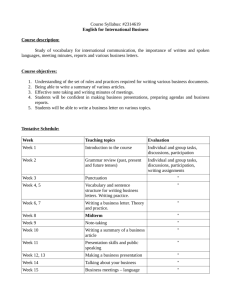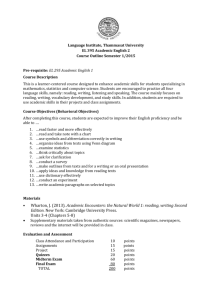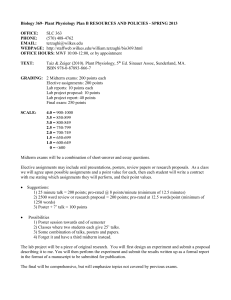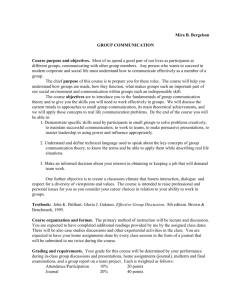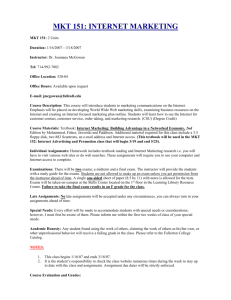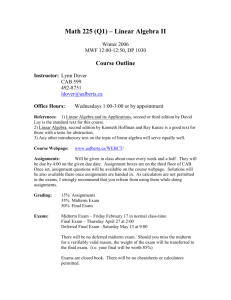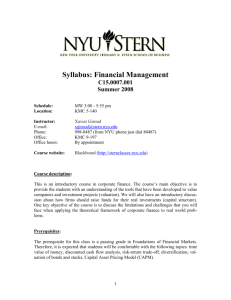Northwestern University Kellogg Graduate School of Management
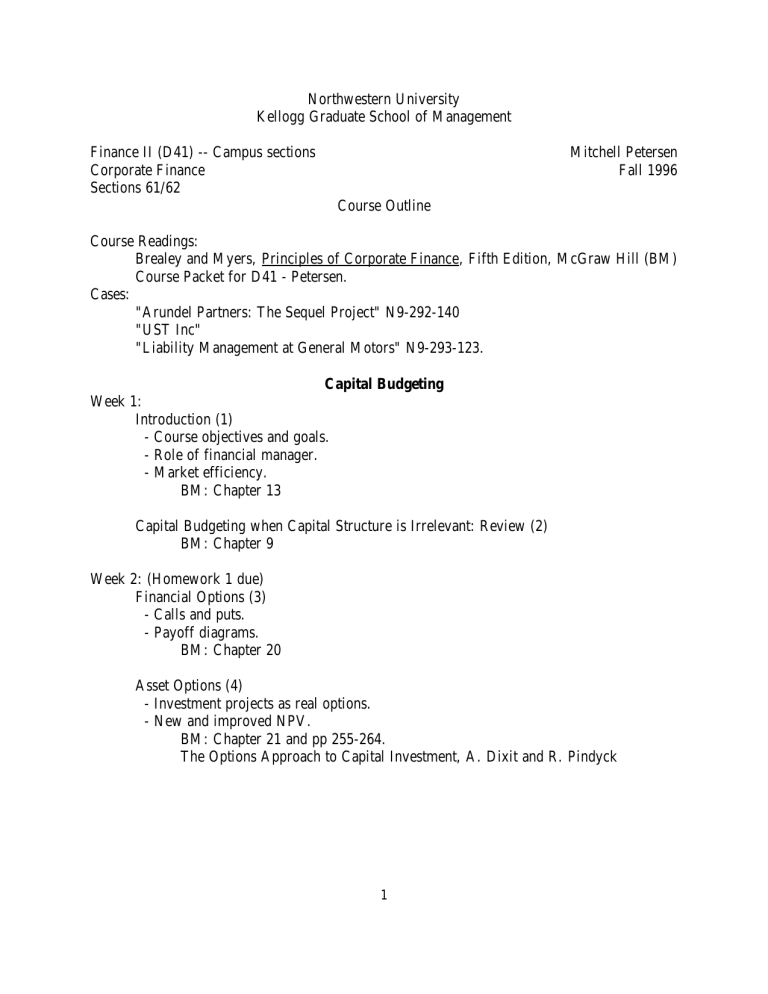
Northwestern University
Kellogg Graduate School of Management
Finance II (D41) -- Campus sections
Corporate Finance
Sections 61/62
Course Outline
Mitchell Petersen
Fall 1996
Course Readings:
Brealey and Myers, Principles of Corporate Finance, Fifth Edition, McGraw Hill (BM)
Course Packet for D41 - Petersen.
Cases:
"Arundel Partners: The Sequel Project" N9-292-140
"UST Inc"
"Liability Management at General Motors" N9-293-123.
Capital Budgeting
Week 1:
Introduction (1)
- Course objectives and goals.
- Role of financial manager.
- Market efficiency.
BM: Chapter 13
Capital Budgeting when Capital Structure is Irrelevant: Review (2)
BM: Chapter 9
Week 2: (Homework 1 due)
Financial Options (3)
- Calls and puts.
- Payoff diagrams.
BM: Chapter 20
Asset Options (4)
- Investment projects as real options.
- New and improved NPV.
BM: Chapter 21 and pp 255-264.
The Options Approach to Capital Investment, A. Dixit and R. Pindyck
1
Week 3: (Homework 2 due)
Dividend Policy Irrelevance (5)
- MM irrelevance proposition.
- Taxes -- do they matter?
Dividend Policy
BM: Chapter 16
The Dividend Puzzle, F. Black
Arundel Partners: The Sequel Project N9-292-140
Arundel Partners case questions
Week 4: (Homework 3 due on Tuesday, October 15th at 12 noon).
Dividend Policy: Signaling (6)
- Event study evidence.
- Asymmetric information.
Quarterly Dividend, J. Aharony and I. Swary
Capital Structure
Capital Structure Irrelevance (7)
- What is debt and equity?
- MM irrelevance proposition.
BM: Chapters 17 (skim Chapters 14 and 15)
Week 5:
Midterm Exam
Capital Structure: Taxes (8)
- Tax incentives of debt
- Personal taxes.
BM: Chapter 18 (pages 474-484) and Chapter 19
Debt and Taxes, M. Miller
Week 6:
Capital Structure: Financial Distress (9)
- Costs of financial distress
BM: Chapter 18 (pages 484-508)
Capital Structure: Signaling (10)
- Event study evidence.
- Cost of underpricing.
The Capital Structure Puzzle, S. Myers
Equity Issues and Offering Dilution, P. Asquith and D. Mullins
2
Week 7:
Capital Structure: Conflicts of Interest (11)
BM: chapter 24 (skim)
Agency Costs of Free Cash Flow, M. Jensen
UST Inc. Case
UST Inc. Case Questions
Estimating Default Probabilities
Applied Topics
Week 8: (Homework 4 due)
Risk Management and Hedging (12)
- Violations of the MM assumptions
BM: Chapter 25 and 224-227.
A Framework for Risk Management, K. Froot, D. Scharfstein, and J. Stein
Topic To Be Announced
Week 9:
Compound and Exotic Securities (13)
- Convertible securities
- Callable/Exchangeable securities
- Warrants
BM: Chapter 22
Liability Management at General Motors Case Liability Management at GM Case
GM Case Questions
Week 10:
Small Business Finance (14)
Thanksgiving -- class will not meet.
Week 11: (Homework 5 due)
Mergers and Acquisitions (15)
BM: Chapter 33
Takeovers: Their Causes and Consequences, M. Jensen
Mergers and Acquisitions (15 continued)
3
Finance II (D41) Professor Petersen
REVIEW SESSIONS
There will be review session for both the midterm and the final. I will announce times in class. This information will also be posted on the corporate finance web page.
ASSIGNMENTS
Deadlines for this class are non-negotiable. If you have a question about a deadline, you should resolve you question prior to the deadline. Under special circumstances you may arrange to turn in assignments early. Assignments will not be accepted after the due date and exams may not be taken late.
Turning in assignments after the due date may provide a student with an "unfair advantage over other students." Students unable to complete the course assignments by the due date will receive a zero for the assignment and may therefore not pass.
Homework Assignments:
DUE DATE
Week 2 - First class
Week 3 - First class
Week 4 - Tuesday, October 15th noon
Week 8 - First class
Week 10 - First class
HOMEWORK ASSIGNMENT
1
2
3
4
5
Homework assignments are due on the day specified. Only homework 3 must be completed for credit. It is worth 30 points. The rest should be done for your benefit. I will hand out answers on the due date, but will not collect your answers. Answers will also be available on the web page after the due date.
Case Assignments:
Cases are due the day we discuss the case. You should turn your answers in at the beginning of class. Case questions are in your packet. You are expected to have read the case and prepared answers. Your answers will be the basis of your contribution to the class discussion. You should make a copy of your answers to refer to during the class discussion. I will collect your case writeup in class. I expect the answers to be both well reasoned and well presented. In the real world, understanding the ideas is important -- being able to explain them to your boss and coworkers is equally important. I will not handout any answers for the cases. The cases are your opportunity to apply the concepts you have learned thus far to messy, real world situations. You will find a spreadsheet program (Lotus, Excel, or Quattro) essential for preparing your answers. I have provided you with data in spreadsheet form for each case. The spreadsheets are available on the corporate finance web page.
You may work in groups of up to 6 individuals on the cases. I strongly urge you to work in groups.
In the past, groups have been more successful than individuals in preparing the cases. I would like you to hand in a memo containing your answers. The memo should be 3-5 written pages plus tables. Brevity is a virtue. Do not repeat the facts of the case -- I have read it.
4
GRADING
There will be two exams. The midterm exam will be given during the fifth week of classes. It will cover the first four weeks of material. The midterm will count for 120 points. The final exam will be given during exam week (the eleventh week of the course). It will cover the entire course. The final will be worth
240 points.
Assignment
Face card
Homework assignment 3
Homework assignments 1, 2, 4, and 5
UST case and GM case
Midterm
Final
Total
Total Points
10
30
0
30 each
120
240
460
Total score = Face card + Homework 3 + 2 cases + max( midterm+final, 3/2 final)
Appointments to discuss anything related to the course may be made by calling (847) 467-1281.
Please make them a day in advance -- please do not just drop by my office. Leave a message if there is no answer. You may also reach me by e-mail at mpetersen@nwu.edu or by fax at (847) 491-5719.
September, 1996
5
Supplementary Readings: These aren't readings which I want you to complete during the course. These are books which I have found interesting as well as informative. If after my class you are interested in additional reading, this list is meant to be my suggestions of where you can start looking.
Valuation: Measuring and Managing the Value of Companies , by Tom Copeland, Tim Koller, and Jack
Murrin, John Wiley, 1991. This is a practitioners guide to valuation, and is on the whole correct.
The New Market Wizards , by Jack Schwager. This book is a series of interviews with very successful traders. These are people who have beaten their respective markets.
Merchants of Debt , by George Anders. This is a about the leveraged buyout firm of Kohlberg Kravis
Roberts and Company.
Capital Ideas , by Peter Bernstein. This book is a history of modern finance. If you read this book you will notice how closely academic and practical finance are intertwined.
Investment Under Uncertainty , by Avinash Dixit and Robert Pindyck. This book is a very in depth look at what we referred to as asset or real options (Lecture 4). If you are interested in learning more, this book may become the most important book in the field.
6

